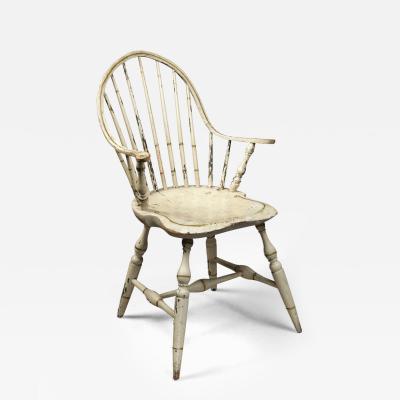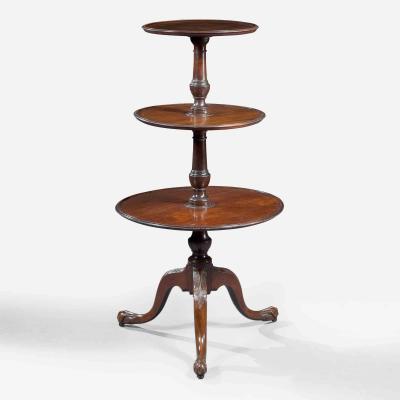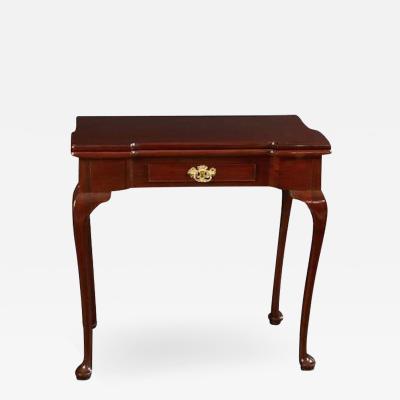All Sorts of Chairs & Joiner’s Work: Pennsylvania Furniture from the Dietrich American Foundation
 |
By Lisa Minardi and Tom Stokes
Pennsylvania—Penn’s Woods—was home to an abundance of natural resources and talented craftspeople, making it an epicenter of furniture production in eighteenth-century America. Drawing on the collection of the Dietrich American Foundation, a new exhibition at Historic Trappe delves into the evolution of Pennsylvania furniture over the course of the eighteenth century. The objects on view run the gamut from an early wainscot chair and a line-and-berry inlaid desk to ornately carved Queen Anne and Chippendale chairs. Presented in the second-floor gallery of the Henry Muhlenberg House, the exhibit allows visitors to experience this furniture in a period domestic setting illuminated by natural light. It also provides a greater context for understanding furniture owned by the Muhlenberg family that is displayed throughout the house’s seven other rooms. The following article will present highlights from the exhibition, which runs through 2023.
 |
Fig. 1: Chest of drawers made for Sarah Thorn, signed by William Beakes III (1691–1761), probably Burlington County, New Jersey, 1721. Walnut, cedar, pine, brass, iron. H. 41-1/4, W. 40-1/4, D. 23 inches. Collection of the Dietrich American Foundation (8.2.3.HRD.1811). Photo by Gavin Ashworth. |
Chest of drawers signed by William Beakes
 | |
| Fig. 2: Detail of the inscription on the chest of drawers in figure 1. Photo by Gavin Ashworth. |
The earliest dated object in the exhibit and one of the earliest known dated examples of Pennsylvania furniture to survive, this chest of drawers was inscribed by the maker on a drawer bottom: “Sarah Thorn her Draws/made by Wm Beakes this 14th of 12th mo 1720”. Under the “new style” or Gregorian calendar adopted by England in 1752 and still in use today, this date would translate to February 14, 1721. Beakes revealed his Quaker roots by using numbered months rather than Greco-Roman inspired names. His grandfather, William Beakes I, was one of the earliest settlers of Bucks County, Pennsylvania, immigrating in 1682 just two months after William Penn arrived in the new colony. Born in 1691, Beakes apprenticed in Philadelphia with the English émigré joiner William Till (d. 1711). Beakes continued working as a joiner, returning to Burlington County, New Jersey, where he is thought to have made this chest of drawers in 1721.1
The Beakes chest expresses many details connected to furniture making in the early 1700s in the Philadelphia region. Made of walnut, the chest has paneled sides framed by stiles that continue to the floor in the back and terminate in turned ball feet in the front. These feet were cut down at some point in the chest’s history but were recently restored for this exhibition based on another, near identical chest of drawers also signed by Beakes.2 The top two drawers have remnants of their original spring locks (also referred to as Quaker locks), in which a wooden shim was nailed to the drawer bottom; to open the drawer, one has to first use a key to unlock the drawer beneath, slide it open, then reach up through a hole in the dust board to press up on the spring lock and allow the drawer to be opened.
 | |
Fig. 3: Side chair, southeastern Pennsylvania, 1700–1730. Walnut. H. 43-1/8, W. 19, D. 18 inches. Collection of the Dietrich American Foundation (8.1.2.HRD.1229-2). Photo by Gavin Ashworth. |
Wainscot side chair
Commonly referred to as a wainscot chair, this joined side chair derives from a medieval style of seating furniture popular in England. Some of the earliest Pennsylvania wainscot chairs continued the English practice of using oak but soon this transitioned to walnut, one of the most popular furniture woods in colonial Pennsylvania. The “wainscot” paneling of the chair reflected its architectural inspiration and was ubiquitous in seating furniture of the English-speaking world by the late 1600s. Manifestations of this form in the Philadelphia area also resulted in a regional style by the 1720s. The Pennsylvania wainscot chair, often associated with Chester County but likely also made in Philadelphia and other neighboring counties, is rectilinear in overall shape; has a recessed or raised panel set within a frame on the back; and has boldly turned legs, front stretchers, and (on armchairs) arm supports—without any carved decoration. The pierced and scalloped crest of the Dietrich chair—flanked by flat, rounded finials on the stiles—places it within a specific subgroup of wainscot chairs made in Pennsylvania in the early 1700s. It is one of a pair; the other example, also owned by the Dietrich American Foundation, is on view at Historic Trappe’s Center for Pennsylvania German Studies.
Line-and-berry inlaid desk
Beginning in the early 1700s, Quaker furniture makers in southeastern Pennsylvania began to experiment with a type of inlaid decoration now commonly referred to as line and berry inlay. More than 125 pieces to date have been documented, including spice boxes, bible boxes, chests of drawers, blanket chests, desks, as well as a high chest and a clock case. Multiple sub-groups are evident within this regional tradition, ranging from highly ornate examples associated with cabinetmaker Hugh Alexander (1724–1777) in the Nottingham area along the Pennsylvania–Maryland border to more restrained expressions attributed to Joel Baily Sr. (1697–1772) of the London Grove area in Chester County. Closer to Philadelphia, joiner James Bartram (1701–1771) of Darby and Marple townships, both now part of Delaware County, is the probable maker of a dressing table, gateleg table, and several case pieces embellished with line and berry inlay.3 The Dietrich Foundation’s slant-front desk is one of only a few examples of this form known with line and berry inlay. Moreover, it is the only desk known in which the drawer fronts, lid, and top are all inlaid. Although the maker is unknown, a distinct feature of this inlay is the tulip-like flower that appears repeatedly throughout the design. The clusters of four, separated dots (or berries) are also particular to this subgroup.
 |  | |
| Fig. 4: Slant-front desk, probably Chester County, Pennsylvania, 1720–1740. Walnut, pine, cedar, gum, oak, brass. H. 42-1/4, W. 37-7/8, D. 21-1/2 inches. Collection of the Dietrich American Foundation (8.2.2.HRD.1966). Photo by Gavin Ashworth. | ||
 |
| Fig. 5: Detail of the inlaid desk in figure 4. Photo by Gavin Ashworth. |
Side chair labeled by William Savery
One of the most studied furnituremakers in 18th century Philadelphia, William Savery opened his own shop in 1742 at the age of 21. Prior to this, he served as an apprentice to fellow Quaker Solomon Fussell (1704–1762) and honed his craft as a chairmaker. Savery’s shop was capable of making fashionable walnut and mahogany furniture but specialized in utilitarian chairs, usually made of maple and fitted with rush seats. The Dietrich Foundation’s chair retains part of Savery’s original label, which advertises "All Sorts of Chairs and/ Joiners Work/ Made and Sold by/ William Savery/ At the Sign of the/ Chair, a little be/low the Market, in/ Second Street/ Philadelphia.” Earlier Savery labels specify “All sorts of rush bottom chairs” but this must have proved too limiting and was removed. The use of bulrush was less expensive than a woven fabric seat, as was the choice of maple rather than walnut or imported mahogany. Other typical Savery chair features seen here are the use of a modest crest rail, simple turned stretcher, and blocky cabriole legs (referred to as a “crookt foot” in the ledgers of Solomon Fussell).4
 |  | |
| Fig. 6, left: Side chair, labeled by William Savery (1721/22–1787), Philadelphia, Pennsylvania, 1765–80. Maple, cedar, rush. H. 40-1/8, W. 21-7/8, D. 19-3/4 inches. Collection of the Dietrich American Foundation (8.1.2.1297). Photo by Gavin Ashworth. Fig. 7, right: Detail of the label on the chair in figure 6. Photo by Gavin Ashworth. | ||
Windsor armchair branded by Thomas Gilpin
Windsor chairs were arguably the most popular form of seating furniture in Philadelphia during the mid-to-late 1700s. First introduced from England, they were made in the city by the 1750s. Thomas Gilpin was the first known Philadelphia Windsor chairmaker to mark or brand his chairs. Born into a prominent Pennsylvania Quaker family, Gilpin worked in Philadelphia from the late 1740s until his death in 1766. The Dietrich Foundation’s example is branded “T GILPIN” underneath the seat pommel and is one of the few extant chairs marked by Gilpin. This armchair contains multiple features of early Philadelphia Windsor chairs, some of which were probably introduced by Gilpin himself, including the turned arm supports and carved volutes on the ends of the crest rail. Most English examples have flat arm supports and the ends of the crest were left plain. Windsor chairs were almost always painted to hide the amalgamation of woods used to build them. This chair currently has a dark varnish over a discontinuous red painted surface—giving it a dark appearance. Traces of the original green paint, a popular color for Windsors in the 18th century, remain underneath the seat and on the ends of the turned elements. One of the most unusual aspects of this Windsor armchair is its diminutive size. The chair is so perfectly proportioned that it may be difficult to detect that it is sized for a young person rather than an adult. At 40-5/8 inches high, the chair is several inches shorter than most Philadelphia Windsors of similar form. The seat is also smaller and lower than full-size examples.
 |  | |
| Fig. 8, right: Windsor armchair, branded by Thomas Gilpin (1700–1766), Philadelphia, Pennsylvania, 1755–60. Poplar, hickory, oak, ash, paint. H. 40 5/8, W. 22 5/8, D. 20 1/2 inches. Collection of the Dietrich American Foundation (8.1.4.HRD.534). Photo by Gavin Ashworth. Fig. 9, left: Detail of the brand underneath the chair in figure 8. Photo by Gavin Ashworth. | ||
 | |
| Fig. 10: Side chair, Philadelphia, Pennsylvania, 1745–60. Walnut, pine. H. 41, W. 21-1/2, D. 20 inches. Collection of the Dietrich American Foundation (8.1.2.HRD.1375). Photo by Gavin Ashworth. |
Queen Anne side chair
The exhibition includes two examples of Philadelphia Queen Anne side chairs, both with the upholstered compass seats and curvilinear forms that characterize this style. Both are also made of walnut, which had not yet been surpassed by mahogany for use in fine furniture. The illustrated example is distinguished by its rounded rear stiles—a refinement over the more typical flat stiles. The chair is further embellished with carved volutes and shells on the knees and crest rail. Its pierced splat evokes a sense of delicacy in the chair’s upper half, contrasting with the sturdiness of earlier chairs with solid splats or paneled backs in the exhibit. This chair is marked with the Roman numeral “V” and was once part of a set; two other examples from the same set are in the collection of the Philadelphia Museum of Art.
Chippendale side chairs
Trapezoidal seats and rectilinear backs help mark these chair’s transition from the Queen Anne to Chippendale style. The pierced splats, however, are still nearly identical in shape to that on the Queen Anne chair. Made of mahogany, both chairs are a tour de force of Philadelphia carving. The chair in figure 11 is attributed to the “Garvan carver,” a highly talented but unidentified craftsman whose expert carving adorns a large body of Philadelphia furniture from about 1750 to 1765. The foliate carving on the crest rail is far less common than the usual shell or cabochon typically found on Philadelphia Chippendale chairs. Made by a different carver, the chair in figure 13 is even more ornate, with extra carving above the knees and two tassels set within the crest rail; few other chairs with this design are known to exist.
 |  | |
| Fig. 11, left: Side chair, Philadelphia, Pennsylvania, 1755–65. Mahogany, cedar. H. 30 1/2, W. 24, D. 20 1/2 inches. Collection of the Dietrich American Foundation (8.1.2.1270). Photo by Gavin Ashworth. Fig. 13, right: Side chair, Philadelphia, Pennsylvania, 1755–70. Mahogany, pine. H. 39 1/2, W. 23 5/8, D. 21 inches. Collection of the Dietrich American Foundation (8.1.2.868). Photo by Gavin Ashworth. | ||
 |
| Fig. 12: Detail of the carving on the chair in figure 11. Photo by Gavin Ashworth. |
Over-upholstered chairs
The latest two chairs in the exhibition are distinguished by the use of over-upholstery, a costly treatment that would have added significantly to their original expense. The Philadelphia chair with Gothic style splat in figure 14 has upholstery stretching over the seat rail and held in place with two layers of brass tacks. It is one of only a few known examples of Philadelphia chairs that survive from this time with over-upholstered seat rails. Originally, it was part of a set, as the Roman numeral “IV” is chiseled into the rear seat rail. Even more lavish is the back stool, a rare form of side chair in which everything but the legs is upholstered. This form was described in the Philadelphia price book of 1772 as a “Chair Frame for stuffing over back and seat, with Marlborough feet.” Its base price, in mahogany, was 1 pound and 5 shillings.5 The pierced brackets on the legs would have been an additional cost, but this was relatively minor in comparison with the multiple yards of fabric needed to cover the chair.
 |  | |
| Fig. 14, left: Side chair, Philadelphia, Pennsylvania, 1765–75. Mahogany, pine. H. 38-1/2, W. 24, D. 20-3/4 inches. Collection of the Dietrich American Foundation (8.1.2.1152). Photo by Gavin Ashworth. Fig. 15, right: Back stool, Philadelphia, Pennsylvania, 1765–75. Mahogany, oak, pine. H. 37-3/4, W. 24, D. 24-1/2 inches. Collection of the Dietrich American Foundation (8.1.1.1190). Photo by Gavin Ashworth. | ||
 |
1. On Beakes, see Jacquelann Killian, “United by Water: Cabinetmaking Traditions in the Delaware River Valley, 1670–1740” (MA thesis, University of Delaware/Winterthur Program in American Material Culture, 2015), 145–66.
2. The signed Beakes chest on which the foot restoration was based sold at Sotheby’s, New York, The William K. du Pont Collection: Important Americana from Rocky Hill, January 22, 2021, lot 7.
3. On line and berry inlay, see Wendy A. Cooper and Lisa Minardi, Paint, Pattern & People: Furniture of Southeastern Pennsylvania, 1725–1850 (Winterthur, Del.: Winterthur Museum, 2011), 12–14, 16–19, 70–78.
4. Benno Forman, “‘Crookt Foot’ and Slat-Back Chairs: The Fussell-Savery Connection,” Winterthur Portfolio 15, no. 1 (Spring 1980): 41–64.
5. Prices of Cabinet and Chair Work (Philadelphia: James Humphreys Jr., 1772), 9.
 |
Guided tours of the exhibition All Sorts of Chairs and Joiner’s Work are available by appointment; contact info@historictrappe.org to schedule. This article is the ninth in a series featuring the Dietrich American Foundation’s collection, intended as a type of crowd sourcing exercise, where responses and information shared by readers can inform the research. New information will be provided over the course of the series. Contact details are in the author bio below. For information about the Dietrich American Foundation, visit dietrichamericanfoundation.org.
Lisa Minardi is the executive director of Historic Trappe. Tom Stokes is the curatorial intern at Historic Trappe and archives assistant at The Carpenters’ Company of the City and County of Philadelphia. Please send comments/queries to info@historictrappe.org.































